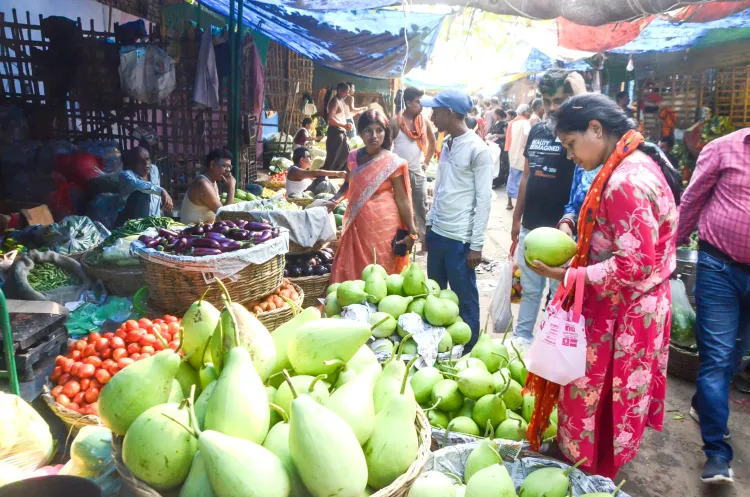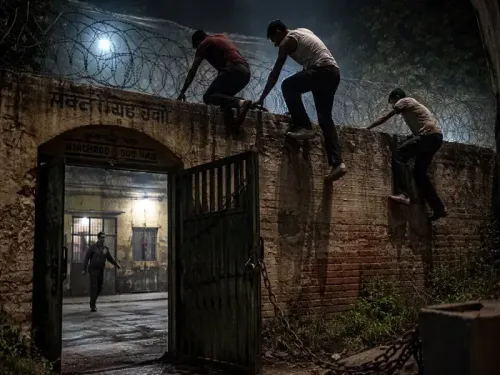What Begins the Four-Day Festival of Faith, Chhath Puja?

Synopsis
Key Takeaways
- Chhath Puja is dedicated to the Sun god and emphasizes nature's harmony.
- The festival includes strict fasting and various rituals.
- Devotees prepare traditional offerings, reflecting purity and gratitude.
- The celebration fosters community spirit and unity.
- Chhath Puja is significant for its cultural and spiritual heritage.
New Delhi, Oct 25 (NationPress) The four-day festival of faith and devotion, Chhath Puja, commenced on Saturday with the sacred ritual of Nahay-Khaay. This celebration, dedicated to the Sun god, honors the balance between nature and humanity, reflecting values of purity, gratitude, and discipline.
On the initial day, devotees, referred to as 'Vratis', immerse themselves in rivers or ponds and partake in a simple, 'sattvic' meal consisting of arwa chawal (plain rice) and lauki ki sabzi (bottle gourd curry) following their prayers. Additional traditional dishes like chana dal, amla chutney, and papad are crafted and later distributed as 'prasad' (ritual food offering).
Mass gatherings are anticipated at various bathing ghats nationwide, where thousands of devotees will engage in the rituals with steadfast faith.
Tracing its origins to the Satyuga and Dwapara Yuga, Chhath Puja is seen as one of the most ancient forms of Sun worship. Devotees practice strict fasting, forgoing both food and water for prolonged periods to demonstrate their devotion and seek blessings of prosperity, health, and happiness. Worshipping Surya during Chhath is believed to eliminate negativity and promote peace and positivity.
Chhath Puja stands as one of the most significant Hindu festivals, especially celebrated in Bihar, Jharkhand, and eastern Uttar Pradesh. It is also recognized in parts of Nepal and among Indian communities globally.
Dedicated to honoring the Sun god and his sister Chhathi Maiya, this festival highlights purity, gratitude, and the well-being of families.
The four-day celebration includes intricate rituals representing purification, faith, and self-control:
Day 1 – Nahai Khai: The festival kicks off with devotees taking a holy dip in a river or pond to cleanse themselves. They gather vegetables and pulses to prepare the first offerings, emphasizing cleanliness and sanctity.
Day 2 – Kharna: On this day, devotees maintain a strict fast from sunrise to sunset. They prepare offerings of jaggery, rice, and wheat, breaking their fast in the evening after presenting offerings to the deity. The 'prasad' is then shared with family, friends, and neighbors to foster unity and community spirit.
Day 3 – Sandhya Arghya: Devotees assemble near water bodies in the evening to offer 'arghya' (prayers and offerings) to the setting Sun. Fruits, sugarcane, and prasad are presented as a token of appreciation to the Sun god for sustaining life on Earth.
Day 4 – Usha Arghya: The concluding day is dedicated to offering prayers to the rising Sun. Devotees break their fast after making their offerings, symbolizing renewal and spiritual rebirth. The prasad is shared among family and community members, marking the end of the rituals.
Chhath Puja is observed with simplicity, dedication, and purity. The offerings, including fruits, vegetables, and sweets, symbolize the gifts of nature, while the practice of fasting and prayer reflects the devotees' intent to purify their body, mind, and spirit. The core essence of Chhath Puja is gratitude, nurturing respect for natural resources and fostering a harmonious relationship between nature and humanity.










